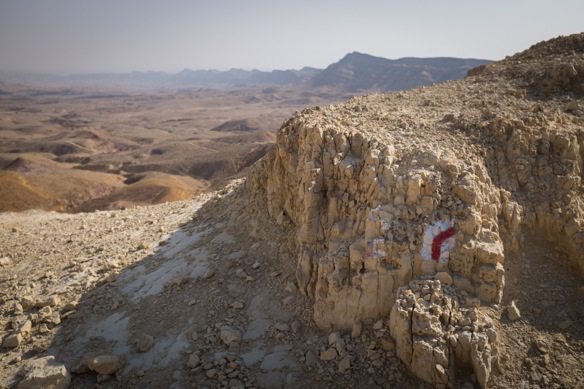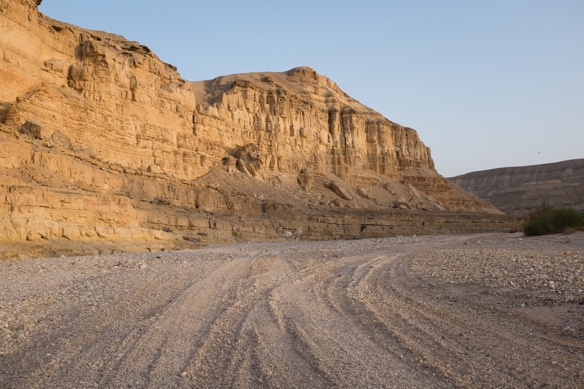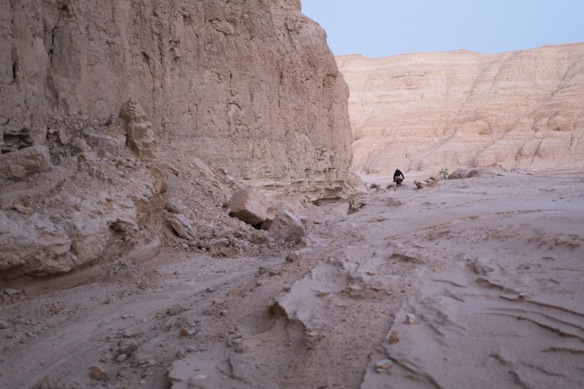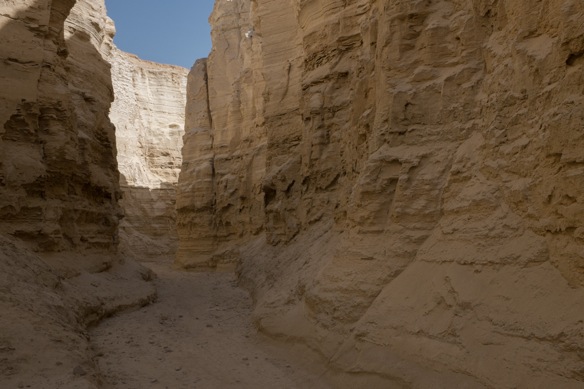
We complete a circle around the Negev desert with Ilan and Danny, connecting new singletrack from Mizpe Ramon with the now familiar HLC route from Tsofar back to Sde Boker. Moving north from Sde Boker, we eventually descend 3700ft to the Dead Sea, over 1200ft below sea level. We ascend an ancient Roman road into a forest along the border of Palestine, we cross paved roads teeming with inexperienced roadies pissing by the roadside on Shabbat asking for snacks from their group’s escort vehicle; we sleep in a cave in a forest park outside Jerusalem and push our bikes through the Old City market in the morning, deflecting questions from Arab vendors about “How much, the bicycle?” while we seek the earthy brown bread they make. Israel, the Negev, Palestine, the Dead Sea, Jerusalem, the West Bank, Area A, Area B, Area C; chalky lime wadi, makhtesh, savvanafication and desertification, kibbutzim, fences, farms, forests, 4×4 tracks, and so many signs and trails, but one simple GPS track from north to south, or south to north. That’s only a few days on the HLC.
The HLC, as you well know by now, is the annual bikepacking race across Israel from north to south, although it really only becomes an annual race after its second running this April. By now, you also know our propensity to follow existing routes through new lands, using them as backcountry highways and approximate touristic guides as we slowly peel away the layers of a place. From scheduled off-pavement touring routes like the Traversée du Massif Vosgien in Alsace, France to rough and tumble footpaths across Poland and the multi-day stage race route across Greece, the Bike Odyssey, we like to know that even when our maps don’t entice us in one way or another, we can continue along a charted path. These routes aren’t challenges to be accomplished and completed, but sometimes-challenging paths of discovery. Most of the time, just as we set off across South Africa on the Dragon’s Spine, we don’t really know what we are in for. Two weeks out of Cape Town I wrote about our growing understanding of strongly institutionalized racism only twenty years after the official dismantling of the Apartheid system, “and I thought I was just bikepacking across South Africa”. There was a lot more to South Africa than dirt roads. There are many things you cannot learn from the internet, or from others. Those are discoveries to be made on the ground.
Seven years ago we looked at dirt routes with curiosity. Several years ago, we pushed onto dirt almost full time, beating around the bush on an old Schwinn High Sierra and a Surly LHT, but singletrack and true all terrain biking loomed. Our current bikes, a Surly Krampus and Lael’s secondhand Raleigh XXIX enable access to most of the riding we encounter. Even so –and we have already spent lots of time on fatbikes– there is a proper fatbike tour in our future. Places like Namibia, Jordan, Finland, Baja California, Australia, Mongolia, Bolivia, Egypt, and Alaska beckon. How best to use a bicycle to reach new places? I’m not ready to abandon the bicycle. Lael talks about walking. I think about fat bikes and full suspension and ultralight, perhaps not all at the same time. Having a bike by my side is a strong habit. Our current equipment is suitable for about 90% of the riding we can expect to find (including pavement, of course), which makes our bikes reasonable, and as close to perfect as one could ask. But the other 10% is fascinating. Maybe it is more than 10%, once the lens of a fatbike is properly focused. A full-suspension bike is a similar extension, although more a difference in degree than in kind.
As for the HLC route, the riding ranks alongside some of the best explorations we’ve had in Europe and uses a similar mix of well-signed dirt roads and walking trails. The chance to ride in the desert reminds us of the AZT, but is far less technical. It is like the Divide, with much less climbing, yet more technical than the endless dirt roads which link Canada and Mexico. The route includes a mix of recently built IBT singletrack, technical jeep trail, sandy wadi, mellow dirt roads, and just a bit of pavement.
No, the politics of the region do not present themselves significantly along the HLC, especially not in the desert. The entire route remains in uncontested Israeli territory, excepting the section in the north in the Golan Heights, which is under full Israeli military control. Israel is extremely safe. However, it is not uncommon to see young soldiers with automatic weapons over their shoulders, a duty of their combat training to keep the weapon with them at all times. Otherwise, overpriced gas station snacks, smooth paved roads, an efficient bus system, and helpful but know-it-all Israelis welcome you as in Germany, or America.
For anyone interested in a bikepacking challenge in the style of the Tour Divide or the AZTR, airfares to Tel Aviv are very well priced including roundtrip rates from NYC for just over $600, and the bike flies free with Aeroflot. It is rumored that the great Scott Morris will be there, alongside AZ compadre Max Morris who returns for a second year. Even Lael is thinking about a nice ten-day riding binge back to the Red Sea. There may be no other bikepacking race in the world that pushes through the crowded marketplace of an ancient city. The HLC starts April 9.
From Sde Boker to the south Dead Sea.

Nearing the rim of Makhtesh Gadol, or the Great Makhtesh– The Big Crater.

Into the makhtesh, a natural non-impact crater found only in this region. The entire makhtesh drains though a single wadi at the southeastern end.

The HLC features miles of mellow dirt roads, sinuous lines of singletrack, and here, some chunky 4×4 tracks.








The Tsin River at -200ft, and still descending.

Weathered date palms and other salt-resistant flora.



A short lungbusting climb to a high vista above the river, still only at -278ft. The lowest point in the USA at Badwater, Death Valley, CA is just four feet lower at -282ft. But I am still on top of a hill.


Our route crosses to an adjacent valley, where we ride a gravelly wadi, recently compacted and cemented by rain. The jeep tracks in the center are softer than the surrounding riverbed, which is often less smooth than the softer tracks in the center. It is a riddle often without an answer, except perhaps a fatbike.


Into a precise and narrow canyon of soft limestone, down to Ein Tamar at the southern end of the Dead Sea. Looks like rock, but is soft like fragile dry clay. Really fun and easy downhill riding, especially when a clear drainage presents itself. This section is signed as a local MTB route.


We arrive in Ein Tamar just after dark and discover a public camp in a spacious town park featuring fresh water and pit toilets. The local grocery is well stocked and open late. We often dream about free, legal camping and cold beers at the end of a long day. The combination usually remains a dream, but is not uncommon in the Negev. In most communities in the desert you may ask for a place to camp, while some even have simple established places for camping. Just ask.

About a kilometer from the town is the southern terminus of the Dead Sea, which is exclusively cultivated for salt production in the south, separated into evaporation ponds. No floating in the water down here.

Additional spoils of our free campsite, and of traveling in a wealthy country. I find 22 strawberry yogurts in the trash at the park, obvious remnants from a picnic on the previous day, discarded alongside plates of Israeli salad and paper coffee cups, and a persimmon. How many yogurts can we pack on our already loaded bikes? Well, about 22. There is always a way. I ate 14 that day. Lael insisted on counting.

Salt ponds, land mines.

Shade.

The HLC follows dirt tracks to the west of the Dead Sea for some time, crossing drainages at the base of the mountains before turning sharply upward and away from the valley.



More chalky wadi riding. Sublime when dry, miserable when wet.

1000ft up an unrideable hiking trail away from Nowe Zohar begins our ascent out of the Jordan Valley. Toward the center of the country, forests and flowers, and Jerusalem!


I’m working hard towards part-time work so I have more time to ride.
Let me know when you are thinking of a Baja fatty tour. I have decades of Baja experience and a deep love for that amazing place.
Maybe we can hook something up?
— Vik
Vik,
Fewer bikes, less work, I cans see where this is headed. Sounds like a solid plan.
We talk about going back to Baja frequently. I’ll let you know if and when we are thinking about riding there. I’m currently in the process of uncovering other fatbike destinations.
You guys get me so stoked to ride bikes! I’m having a great time reading and dreaming and pedaling. I can tell an extended bike adventure is in my future and your blog is helping me realize it. Awesome! Keep shredding dudes!
Thanks Hobbs! We’ve finally made it to the forested center of Israel and had the chance to meet a group of riders on Shabbat at the most popular local destination for mountain biking, the Ben Shemen forest. I was amazing to see hundred of people coming and going and dozens of amazing high end bikes from Niner, Santa Cruz, Spec, Yeti, Ibis, etc. Even though the trails aren’t very technical, the “trail” culture has caught on in a big way. Cool and funny to see skinny old guys and new riders on expensive bikes with knee pads. Very cool to see so many people riding bikes, for sure. If only they had your riding skills. The things you can do on a Klunker…
Ha! Nick you are too kind! All of the things I can do on a Klunker end on the ground, regardless of how entertaining the middle part is! After so many miles of so few bikes it must be somewhat of a culture shock to be back in big city type flow trail culture. Fatbike culture is blowing up here in town, I see nearly as many fatbikes out as I saw trail bikes last summer. Its impressive. My girlfriend, Danielle,and I have joined the fatbike craze and are stoked on it. As she gains experience on a bike she has voiced interest in doing some casual overnights… good things are ahead! It’s awesome you get to shred some buffed out town trails! Show those fancy carbon bikes how to rip!
14 yogurts on one day? Wow, that must be some kind of a record man 🙂
In the past I’ve kept a serious 1L per day regimen, and since I’ve tapered my intake recently, 14 little ones wasn’t too difficult. It was easier than carrying up to Arad from the Dead Sea!
Love your post and the photos, as always. We just completed the coldest February since the weather service has been recording the weather in Western New York. Not that you are unfamiliar with cold, but we here might struggle with trying to remember how to pedal a bike! (The rollers and wind trainers are getting way too much use.)
Thanks Keith!
Where in Western NY? I grew up in CNY, in Cortland, and my folks are living up north in Watertown. I’ve been following winters in NY and in AK, looks like you got the bigger dose for sure. Record low snow year in much of Alaska, I think.
So interesting, the tire size and width conundrum for the adventure cyclist.
It can take a lot of experimentation, or just settling on something and going with it. We know that one size is not appropriate for all conditions.
Big rubber can become a burden when rolling down the tarmac or graded metal road. Narrow tires force us to swim or hike in loose conditions. Suspension is glorious when needed, detrimental when not, and adds a layer of complexity to the bike.
My tires won’t be getting any fatter than 406-63 (20×2.4) for my portable bike. That is enough air and rubber for most conditions. Any bigger (there are 20” fatbike tires now) would make the design exceed size restrictions for checked luggage on bus and airplane transport. Rather than ride a long ways on the bumpy train tracks, I would probably just fold it up and get on the train itself.
Ian Hibbell used his racing bike for trekking all over the world. Sliding about in loose dirt or just dragging his bike thru the wilderness was he expected. His account of the powdery sand in the Sahara causing his wheels to sink hub-deep is rather amazing. I wonder if a fatbike could ride very far in conditions like that…
Ira Ryan rode his 38mm tire bike on the Oregon Outback ride in record time. Swimming thru the “red sauce” volcanic gravel in the 30 mile Deschutes forest section would make most people yearn for bigger tires, but his strength and motivation kept him in the lead.
My month long tour in New Zealand in the mid 70s on a Mondia with 35mm tires included as many dirt roads as possible. The only part I needed to walk to any extent was on the 50 mile long Heaphy track. Soon after leaving Westport, intermittent walking started. Later, I needed to remove my pedals to negotiate most of the trail. Getting it across all those long cable bridges was a challenge. The bike carried all my stuff on that 2 day trip where I needed to walk about 3/4 the route thru the beautiful birch forests. It was nice to not shoulder a backpack, and I liked having the bike with me; it was perhaps the most memorable part of the trip.
That said, the 4 to 5” tires on a fatbike do offer a riding experiences unlike anything else. I look forward to some camping trips on my Pugsley this year!
Drew,
When i say perfect, I mean perfect for our needs.
I don’t believe our current bikes are a hindrance on pavement, and minor changes such as increased tires pressure (or different tires, long-term) make them even more suitable to paved travel. I also don’t ascribe to the idea that “skinnier is faster”–at least not so simply, there is a lot more to it. Most importantly, our bikes are lightly packed, reasonably aerodynamic, and generally well tuned. All things being equal, road bikes are faster and easier to pedal on smooth surfaces, but I’ve see too many “touring bikes” with skinny tires and lots of gear, poorly tuned, broken spokes, uncomfortable drop bars, claimed to be better than my mountain bike for paved riding. But as you describe, dirt routes are not ideal on such bike, or not possible.
I am considering a proper paved tour in the future. It might be time to eat a lot of ice cream on the Trans-Am route. I’m thinking something like a Salsa Warbird with bikepacking luggage would be my ideal bike.
Fatbikes can be a lot of work on paved roads. It is possible, but is far from ideal due to weight, friction (traction), and poor aerodynamics. Don’t forget, I rode a Pugsley from Alaska to New Mexico. I have a great appreciation for what fatbikes do well, and where they falter, and which workarounds exist to overcome them. But the fatbike trips I refer to would be of a very different nature than our current travels. I’m thinking of a series of destination fatbikes trips, several months each, in several parts of he world. This wouldn’t be about “fatbikes can do everything”, but “fatbikes can do exceptional things”. That’s the 10% I refer to. The point is to use the fatbike in scenarios where other bikes cannot ride. The fact that Ian Hibell dragged his bike across the Sahara makes him a badass, but does not qualify his bike as anything other than dead weight in that situation. Surely a fatbike could do much better, although there would still be sizable unrideable sections. Dry steep dune sand is likely impossible to ride uphill, but half the world is downhill.
I’ve also spent considerable time on 28, 32, 38, 45, 50mm tires, choosing increasing tire sizes over the years as I outgrew the last, swimming around in the sand or dirt as you describe. This includes some dirt road riding on 28/32mm tires. It was possible, it was fun, but it was far from ideal. That which was possible on 32 or 38mm tires is fun on 2.0s.
Ira was the strongest rider at the start line of the Oregon Outback, and his bike should not be considered the ideal for non-Herculean tourists like us. From what I have seen, something like a Fargo with fast rolling 2.0″ tires would be nearest to an ideal for most riders on the Outback.
Thanks for the insight, Nicholas, your experience with riding challenging trails/tracks is much greater than mine.
I am happy to see the trend toward bigger tires these days. If Mr Hibbell was still with us, I think he would go big too. He didn’t have that opportunity with what was available during his time.
For even a small increase in tire size, a new frame and fork design is needed. This is one factor in the slow transition to wider tires. The other factor is that old habits die hard, and the still present narrow tire/racing mindset.
I like the idea of a one bike that can do most of it concept too. But it sounds like the 10% rides you refer to is a special category, requiring a special bike. Perhaps like Scott and Toms Australia outback ride along the Canning Stock route on custom fat bikes?
Thank you for continuing to post such wonderful writing and pictures.
Yes, the 10% rides are special, like the Canning Stock Route, like the Iditarod, etc. I’m not certain if I am ambitious enough to do the work to schedule a series of fatbike specific tours, but for some reason my mind has been wandering toward fatbikes lately. Perhaps it is the sandy deserts or the feeling of missing the winter riding season in AK. But a lot has changed with fatbikes and mountain bikes that makes them more capable and less of a burden at the same time.
Our friend Christina came to ride with us for ten days recently, and she brought her 9zero7 Whiteout, a carbon frame with mostly carbon parts including some really incredible carbon rims. The total bike with platform pedals and tubeless tires was 24lbs, much lighter than my bike or Lael’s. When you remove the weight penalty from the equation, the conversation becomes a lot more interesting. Now the potential disadvantages are unwanted friction when you don’t need it (or traction, when you need it), lessened aerodynamics, and on trail characteristics. The trail manners I refer to are not for paved roads or sandy snowy trails, but for trails that are better served by mountain bikes.
For me the disadvantages to aerodynamics are insignificant and excusable; the rolling resistance on roads is mitigated by increased pressure and many tires like Husker Du, Larry, Knard roll very well; but the unique trail manners of a rigid fatbike on technical mountain bike trails keeps me on a 2.3-2.4″ tire for now, with a suspension fork. All that being said, I look forward to the new 27+ size, which features the outside diameter of a 29″ tire with the girth of a 3.0″ tire inside a normal drivetrain with shorter chainstays than 29+. A 3.0″ tire has far better manners than a 4-5″ tire, yet has capabilities a 2.0″ can only dream about.